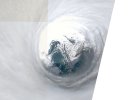Pressure is used by meteorologists instead of height because the atmosphere isn’t a fixed stack - it stretches and squashes with temperature. In a warm storm (like a hurricane), the air column bulges upward; in a cold system, it sinks. So "15,000 feet" might mean totally different things depending on the weather. Pressure, on the other hand, always tells you how much air is above you. That makes it a consistent way to mark layers of the atmosphere - 850 mb, 700 mb, 500 mb - no matter how tall or short the column gets.
In a hurricane, in Jamaica, in October - approximately:
- 1000 mb – sea level
- 925 mb – ~2,500 ft (750 m)
- 850 mb – ~5,000 ft (1.5 km)
- 700 mb – ~10,000 ft (3 km)
- 500 mb – ~18,000 ft (5.5 km)
- 300 mb – ~30,000 ft (9 km)
- 200 mb – ~39,000 ft (12 km)
Winds in a dropsonde are calculated by using its onboard Global Positioning System (GPS) receiver to track its horizontal movement as it descends through the atmosphere. The dropsonde's horizontal position is recorded at very short intervals (typically every 0.25 seconds), and a computer processes this data to determine the wind speed and direction at different altitudes. "
So when you are talking about wind speed, a dropsonde isn't measuring it, the dropsonde's flight IS the measurement. Yeah, that sucker was flying 252MPH sideways as it fell, blown by the hurricane, when it was at that level. This is also why you would see dropsonde reports coming after the plane passed through the area it measured by a few minutes, and why their markers were sometimes a LONG way away from where the plane was, but in an arc around the storm. Pretty cool, huh?
(Folks smarter than me feel free to expand on or correct anything I oversimplified there)


